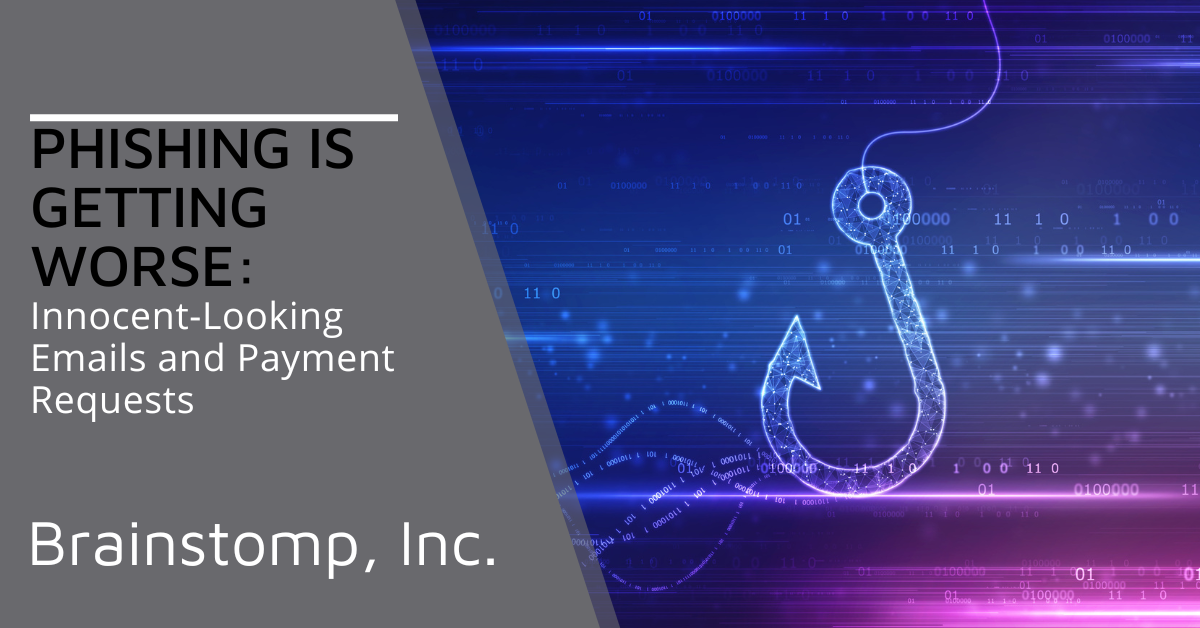Phishing is Getting Worse: Innocent-Looking Emails and Payment Requests
/In today’s digital age, cyber threats are on the rise, and one of the most common and dangerous among them is phishing. Phishing attacks have evolved significantly over the years, becoming increasingly sophisticated and harder to detect.
Cybercriminals are constantly finding new ways to trick unsuspecting individuals into divulging sensitive information or performing actions that can lead to financial loss or data breaches. Among the various phishing techniques, email-based phishing remains one of the primary vectors for attackers. In this article, we will explore how phishing is getting worse, particularly focusing on innocent-looking emails and payment requests that can deceive even the most cautious users.
The Innocent Facade of Phishing Emails
Phishing emails are crafted to appear innocent and legitimate, often mimicking official communications from trusted organizations, friends, or colleagues. The attackers invest time and effort to make these emails look as convincing as possible, including using logos, language, and formatting that closely resemble authentic messages. They may even employ personalized details, such as the recipient’s name and other publicly available information, to enhance the illusion of authenticity.
However, the true intentions behind these emails are far from innocent. The ultimate goal is to deceive the recipient into taking specific actions, such as clicking on malicious links, downloading infected attachments, or revealing sensitive information like passwords, credit card numbers, or account credentials. These actions can lead to severe consequences, ranging from financial loss to identity theft and data breaches.
The Danger of Innocent-Looking Attachments
Attachments are a common method used by cybercriminals to deliver malware to victims’ devices. In the case of phishing emails, attachments may appear harmless, often disguised as everyday files, such as PDFs, Word documents, or images. Unwary users who download and open these attachments can unknowingly install malware onto their systems, giving attackers access to sensitive information or control over the compromised device.
It’s crucial to exercise extreme caution when handling email attachments, even if they seem to come from a reliable source. Never open an attachment unless you are absolutely certain of its authenticity. Always verify the sender’s email address and content before downloading anything. If in doubt, contact the sender through a separate, trusted communication channel to confirm the legitimacy of the attachment.
Recognizing Suspicious Email Requests
Phishing attackers often employ psychological tactics to manipulate recipients into fulfilling their requests. One common tactic is to create a sense of urgency or fear to prompt immediate action. For instance, an email might claim that an account has been compromised, and the user must reset their password immediately by clicking a provided link. These scare tactics can cloud judgment and lead to hasty decisions.
Another common type of phishing email involves payment requests. The email may appear to come from a known vendor or service provider, asking the user to make a payment urgently. These requests often contain a sense of urgency and may threaten negative consequences if the payment is not made promptly. Users who fall for this tactic could end up transferring funds to the attackers’ accounts, leading to financial loss and potential legal repercussions.
To avoid falling victim to these types of scams, be cautious of emails that demand immediate action, especially when it comes to financial transactions. Always take the time to verify the authenticity of the email and the legitimacy of the request. If you receive a payment request via email, cross-check it with previous communication or contact the vendor directly through their official website or phone number to verify the request’s validity.
How to Protect Yourself Against Phishing
Protecting yourself against phishing requires a combination of awareness, caution, and security measures. Here are some essential steps to safeguard yourself and your organization from falling prey to phishing attacks:
Educate Yourself and Your Team: Stay informed about the latest phishing techniques and regularly update your team about potential threats. Awareness is the first line of defense against phishing attacks.
Inspect URLs and Email Addresses: Hover your mouse over any links in an email to see the actual URL destination. Verify that the domain is correct and does not contain misspellings or suspicious characters.
Enable Multi-Factor Authentication (MFA): Implement MFA whenever possible to add an extra layer of security. Even if attackers obtain your login credentials, they will face an additional authentication step.
Use Advanced Email Security Solutions: Invest in robust email security solutions that can detect and block phishing attempts before they reach your inbox.
Report Suspected Phishing Emails: If you receive a suspicious email, report it to your IT or security team immediately. This helps them take appropriate measures and warn others.
Protecting yourself from phishing requires diligence and vigilance. By staying informed, remaining cautious, and adopting robust security measures, you can significantly reduce the risk of falling victim to these malicious attacks.
Protect Yourself Today
Phishing attacks, especially through email and payment requests, are becoming more deceptive and sophisticated, posing a significant threat to individuals and organizations alike. Cybercriminals use innocent-looking emails and attachments to trick users into divulging sensitive information or performing actions that can lead to financial loss and data breaches. Vigilance and awareness are crucial to protect ourselves from these evolving threats.
At BrainStomp, we take cybersecurity seriously and are committed to helping individuals and businesses stay safe from phishing attacks and other cyber threats. If you have any questions or need assistance with improving your cybersecurity posture, contact us at BrainStomp today. Stay safe online!


